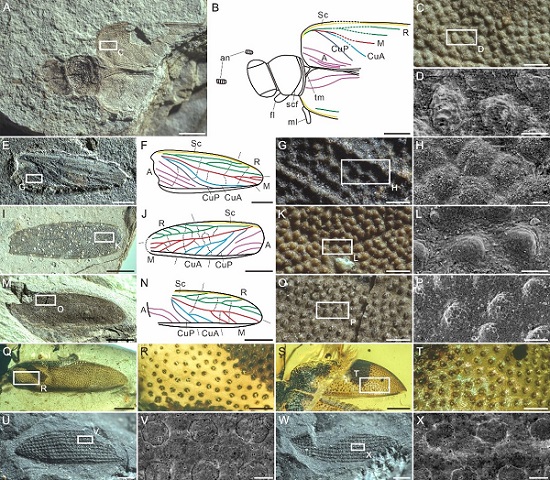Umenocoleidae is one of the most perplexing fossil insect groups. It was first established based on a specimen (Umenocoleus sinuatus Chen et T’an, 1973) from the Lower Cretaceous of Yumen City (Gansu Province, northwestern China). The systematic position of the genus has long been disputed, and it has variously been assigned to stem-group Coleoptera, Protelytroptera, Blattaria, stem-group Dictyoptera, or Mantodea, mainly because its sclerotized forewings and its forewing venation similar to stem-group Coleoptera, some groups of Dictyoptera, and Protelytroptera.
Some researchers restricted Umenocoleidae to its type genus Umenocoleus and retransferred it to Coleoptera, proposing the placement of Umenocoleus as sister group to all other beetles, while the other genera remained in Dictyoptera. If it is true, the systematic position of Umenocoleidae will be very important for us to understand the origin and early evolution of Coleoptera. However, the placement of Umenocoleus is still under debate.
Recently, Mr. LUO Cihang, a postgraduate student, supervised by Prof. WANG Bo and Prof. ZHANG Haichun come from the Nanjing Institute of Geology and Palaeontology, Chinese Academy of Sciences (NIGPAS), studied new specimens from the type horizon of the type locality (Lower Cretaceous Zhonggou Formation at Jiuquan, Yumen City, China). The result indicates that the Umenocoleidae is likely a specialized taxon of Dictyoptera, sister to Alienoptera. The beetle-like appearance is a result of convergent evolution. This research was published on Palaeoworld.
The research group described three new specimens from the type horizon of the type locality (Lower Cretaceous Zhonggou Formation of Yumen City, China), one of the type species, and two forewings of Ponopterix, a genus potentially closely related to Umenocoleus. They also re-examined the forewings of U. nervosus from the Lower Cretaceous Dalazi Formation, and two additional species (Enervipraeala nigra Luo, Xu et Jarzembowski, 2021, and another based on one undescribed specimen) preserved in mid-Cretaceous Kachin amber. The results revealed that though cup-shaped punctures on the forewings of Umenocoleidae are superficially similar to the window punctures of stem-group Coleoptera and extant Archostemata, their micro-structure are different.
The researchers also carried out a phylogenetic analysis based on a matrix with 72 characters and 36 terminals, which provided robust evidence that the Umenocoleidae is a specialized taxon of Dictyoptera, sister to Alienoptera. Menocoleidae was a successful globally distributed family during the Early Cretaceous but had never been discovered from the Late Cretaceous, which probably accompanied by the decline of gymnosperms and in competition with wood-associated polyphagan beetles. Umenocoleidae (and also Alienopteridae) were apparently a failed attempt of roachoids to occupy a new microhabitat.
This research was jointly funded by the Strategic Priority Research Program of the Chinese Academy of Sciences, the Second Tibetan Plateau Scientific Expedition and Research, and National Natural Science Foundation of China.Mr. Yan Fang and Ms. Chun-Zhao Wang of NIGPAS were acknowledged for their help with the SEM analysis.
Reference:Luo, C.-H., Beutel, R.G., Thomson, U.R., Zheng, D.-R., Li, J.-H., Zhao, X.-Y., Zhang, H.-C., Wang, B., 2021. Beetle or roach: systematic position of the enigmatic Umenocoleidae based on new material from Zhonggou Formation in Jiuquan, Northwest China, and a morphocladistic analysis. Palaeoworld. https://doi.org/10.1016/j.palwor.2021.01.003

Fig. 1. Photographs and line drawings of Umenocoleidae

Fig. 2. Systematic position and distribution of the Umenocoleidae

Fig. 3. Ecological reconstruction of Umenocoleidae (drawing by Jahao Li)
Contact:
LIU Yun, Propagandist
Email: yunliu@nigpas.ac.cn
Nanjing Institute of Geology and Palaeontology, Chinese Academy of Sciences
Nanjing, Jiangsu 210008, China
